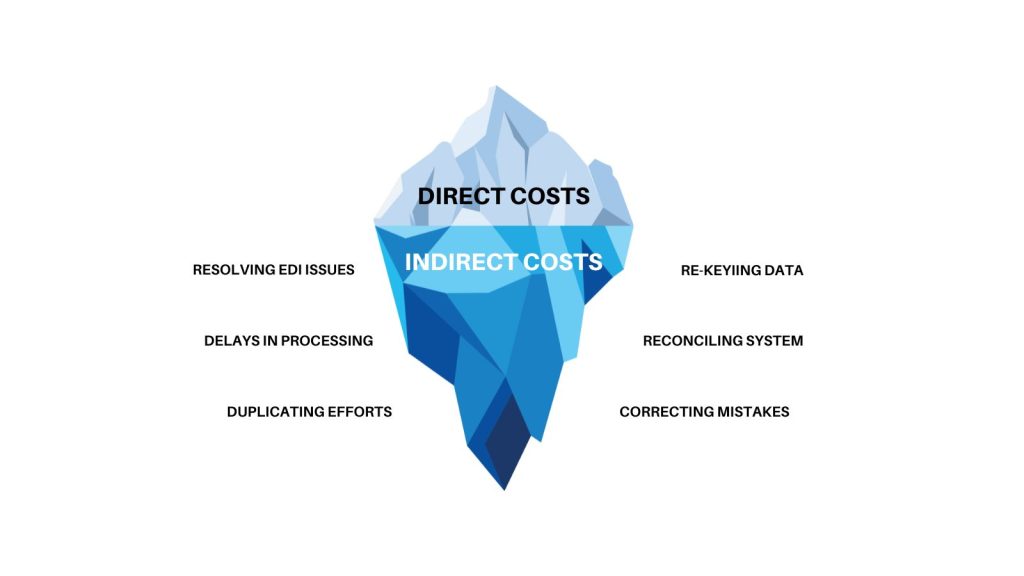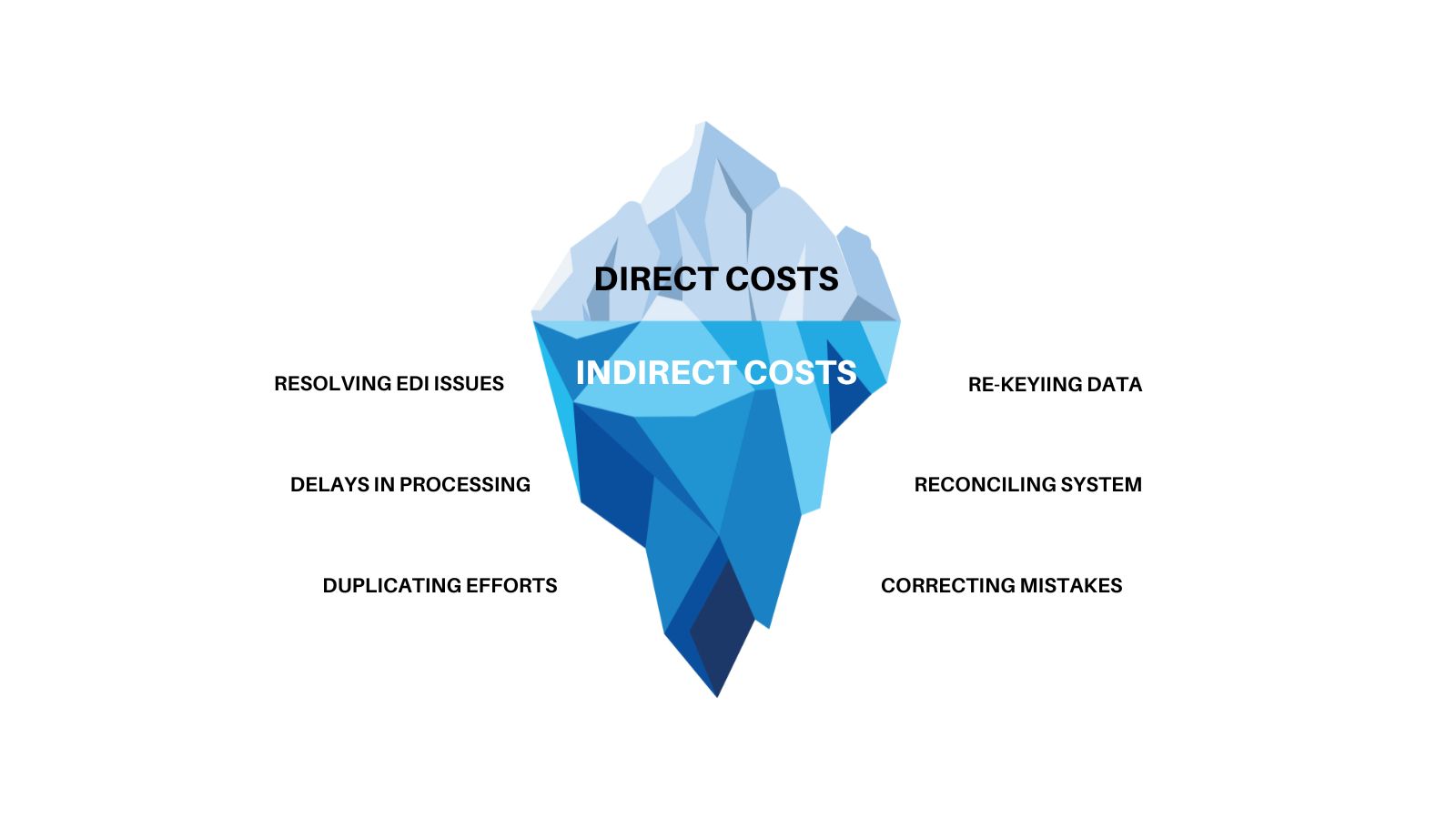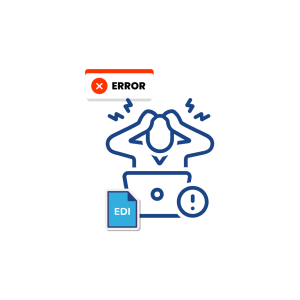EDI Costs
The cost of an Electronic Data Interchange (EDI) system can vary depending on various factors such as the size of your business, the complexity of your EDI requirements, the number of trading partners you need to connect with, and the specific EDI software or EDI service provider you choose.
A basic setup may cost a few hundred dollars per year, while a more advanced system with multiple trading partners can range into several thousand dollars annually.

The Key Difference Between EDI Costs
Hard EDI Costs
Hard EDI costs, also known as direct costs, which have an immediate impact to your bottom line, can come in the form of compliance charges if the problem you’re having means your outbound documents aren’t meeting your trading partners’ requirements. Often charged per document, these can add up quickly if the problem is a systemic one that isn’t caught, and the mapping process that translates data from your ERP, Accounting, or another business system into the EDI document that is sent is not corrected.
Seemingly one-off problems can be easily caught by a conformance-checking process if that’s something your EDI system enables.
Other hard costs can arise as a result of either missed orders that get lost in ‘the cloud’, or invoices that are never delivered to your customers. Missed orders may not only mean that you miss out on that specific revenue, but can also aggressively sour your customer relationship, which in turn can contribute to declining sales.
Invoices that don’t make it to your customers on time can have a serious impact on your cash flow, as payments become delayed.
Soft EDI Costs
Soft EDI costs, which are also known as indirect costs, are those that you don’t see on your monthly expense reports, but chew up your resources, distracting them from contributing to your business growth. These costs result from problems that take employee time to identify, work around, and/or resolve, such as performing track-and-trace with your provider or VAN, manually matching functional acknowledgments (aka 997s), and manual steps involved in ‘doing EDI’ if your system isn’t fully automated. These issues are tedious and time-consuming for employees, meaning that energy is misallocated here as opposed to being spent on building customer relationships, processing orders, and other functions that ultimately help the business thrive.
These types of EDI problems aren’t just an inconvenience – they also impact your business’s earning potential immensely – and if you are experiencing these issues, it’s likely a sign that your EDI ‘solution’ isn’t doing its job. An EDI solution should be reliable. Documents should not go missing or be delivered late. Outbound documents should be validated, and you should be confident that you won’t receive rejection notices or compliance charges from your trading partners. A service provider should be ready and willing to answer questions quickly and clearly and should understand how ‘EDI problems translate into real-world business problems.
Here are some other costs associated with EDI Implementation
1. Software License
If you choose to purchase EDI software, you may incur a one-time cost for software licenses. The cost can vary greatly depending on the functionality and features of the software.
2. Type of EDI solution
Depending on the type of an EDI solution you choose, whether it’s a cloud-based, on-premise, or hybrid solution, your EDI costs will vary.
3. Implementation and Setup
Implementing and setting up an EDI system may require professional services, such as consulting or EDI integration, which can add to the overall cost. This cost will depend on the complexity of your EDI requirements and the level of customization needed.
4. Maintenance and Support
EDI systems may require ongoing maintenance, updates, and support, which can involve recurring costs. These costs can include software maintenance fees, technical support fees, and updates to keep the system current.
5. VAN or AS2 Fees
If you use a Value-Added Network (VAN) or AS2 (Applicability Statement 2) for transmitting EDI documents, there may be associated fees for VAN or AS2 services. These fees can vary depending on the volume of data transmitted and the service provider you choose.
6. Trading Partner Fees
Some trading partners may require you to use a specific EDI provider or may charge fees for EDI transactions, such as per-document fees or subscription fees.
7. Data Volume
The amount of data you exchange through EDI will impact the cost.
8. EDI Provider Fees
Different providers have varying pricing structures, including per-transaction fees, monthly subscriptions, and setup costs.
9. Internal development costs
If you need to modify your internal systems to integrate with EDI, it can add to the cost.
10. Network Access Fees
Fees associated with connecting to the EDI network.
How to reduce the costs associated with implementing and maintaining an EDI system?
1. Choose the Right EDI Solution
Carefully evaluate different EDI solutions and providers to find the one that best fits your needs and budget. Consider factors such as software licensing costs, implementation fees, maintenance and support fees, VAN or AS2 fees, and trading partner fees when comparing options. Look for providers that offer flexible pricing plans and scalability options that can grow with your business.
2. Opt for Cloud-Based EDI
Cloud-based EDI solutions are becoming increasingly popular as they offer cost-effective and scalable options. Cloud-based EDI eliminates the need for costly hardware, software, and infrastructure investments, as the EDI software is hosted and maintained by the provider. Cloud-based EDI also often includes automatic updates and maintenance, reducing the need for in-house IT resources.
3. Consolidate Trading Partners
Consolidating your trading partners onto a single EDI platform or provider can help reduce costs. Working with a single provider may allow you to negotiate better pricing and streamline your EDI processes, reducing the need for multiple VAN or AS2 connections and associated fees.
4. Automate EDI Processes
EDI Automation can help reduce costs by minimizing manual effort, reducing errors, and improving efficiency. Look for EDI solutions that offer features such as automated document mapping, validation, and routing, as well as integration with your ERP or other business systems. Automation can help reduce the need for manual intervention, saving time and resources.
5. Monitor and Optimize EDI Usage
Regularly review your EDI usage and associated costs to identify any inefficiencies or areas for optimization. Monitor transaction volumes, VAN or AS2 fees, and trading partner fees to ensure they align with your business needs. Consider periodically renegotiating contracts or seeking better pricing from your EDI providers.
6. Stay Informed about Industry Standards
Staying informed about industry standards, such as EDI protocols, document formats, and communication methods, can help you avoid unnecessary costs. By adhering to industry standards, you can ensure seamless communication with your trading partners and minimize the need for customization or workarounds that may increase costs.
7. Cost-Benefit Analysis
8. Compare Providers
9. Negotiate Contracts
Conclusion
It’s important to note that EDI costs can vary greatly depending on your specific needs and requirements. It’s recommended to obtain quotes from multiple EDI providers and carefully review the pricing structure and terms to determine the total cost of implementing and maintaining an EDI system that meets your business needs.
Want to learn more about EDI?
Here is the complete guide to EDI
Ready to find out how much Commport EDI Solutions Cost?
Download: EDI Buyers Guide
Unlock the full potential of your supply chain with our comprehensive EDI Buyer's Guide — your first step towards seamless, efficient, and error-free transactions
Frequently Asked Questions
- The primary cost components of implementing EDI include software licensing fees, setup and integration costs, VAN (Value Added Network) fees for communication, ongoing maintenance and support costs, and potentially, EDI training for staff.
- EDI costs can vary based on the size and complexity of the company. Larger enterprises may have higher upfront costs due to their larger transaction volumes and more intricate integration requirements, while smaller businesses might benefit from simpler setups with lower initial investments.
- While the main costs are typically transparent, there can be hidden costs such as customization fees for tailored solutions, data mapping and translation expenses, and potential penalties for non-compliance with EDI standards or regulations.
- Yes, implementing EDI can lead to significant cost savings over time. By automating manual processes, reducing errors, speeding up transactions, and improving overall efficiency, businesses can experience savings in labor costs, paper usage, postage, and fewer chargebacks due to errors.
- Businesses can manage and control EDI costs effectively by conducting thorough research and comparing different EDI service providers to find the most cost-effective solution for their needs. Additionally, optimizing internal processes, investing in EDI training for staff, and regularly reviewing and renegotiating contracts can help minimize costs over the long term.





